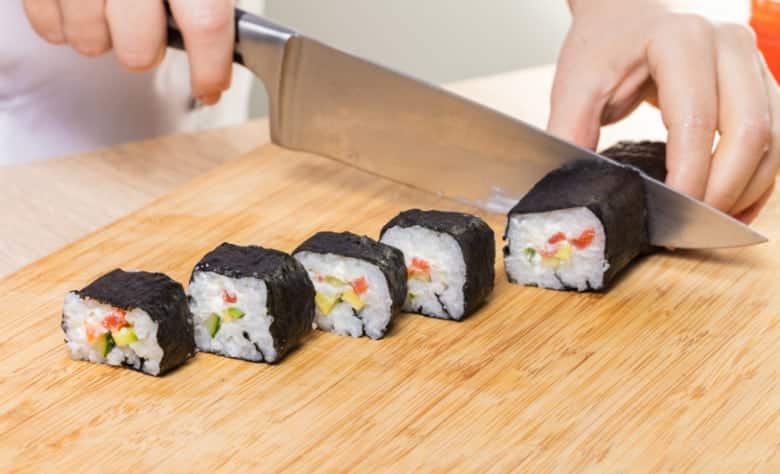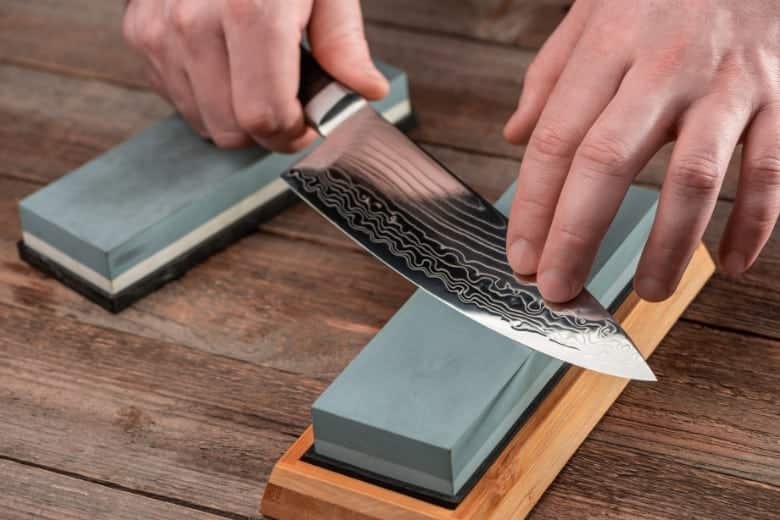The chef knife is arguably any cook’s most important tool. Whether you are a beginner or a professional chef, you’ll need a trusty blade to tackle different tasks from mincing to chopping to fileting and more.
Over time Japanese knives have won a well-deserved reputation for producing some of the finest knives in the world. I reviewed 6 different Japanese kitchen knives and found the Shun Classic 8” Chef Knife to be the best overall, and my personal favorite.
Before we get into the finer points of the best Japanese knives, I’ll give a little background on the history of Japanese knife making and the differences between Japanese and German knives.

The History Of Japanese Knives
In the world of cookware, Japanese knives stand out, and with good reason. There has been a long-standing tradition in Japan for producing exceptional blades–a tradition that extends as far back as the 9th century.
Before bladesmiths were forging knives they were handcrafting swords, specifically the katana or samurai sword. The katana was seen as an extension of the soul of the samurai who wielded it.
By the end of the 19th century, the age of the samurai had ended. In response, the market shifted and former swordsmiths turned their attention to crafting knives.
The same spirit that permeated sword culture extended to knives. Like the samurai, the chef in Japanese culture was seen to pour out a part of his soul into his knife. In this way, the craftsmanship that had been dedicated to making elegant and deadly swords was directed to kitchen knives.
It is not uncommon for cooks to have many different types of knives in their arsenal, from filleting knives to cleavers made specifically for chopping root vegetables. Japanese knives are an exciting world for any home cook to explore!
Japanese Vs German Knives
Perhaps the first question any new knife buyer should ask is whether they want a German or a Japanese knife. Both styles are well regarded but have different strengths.
German knives are typically known for being durable, long-lasting, and versatile. They are great all-around knives and can tackle many different types of ingredients and preparation styles. The type of steel used in German knives is typically softer, which means their blades last longer but do not hold their edge as long.
Japanese knives have a reputation for being lightweight and precise. Designs are often elegant and refined. Because the steel used for Japanese knives is typically harder it is also more brittle and prone to breakage over time. That is not to say that these knives aren’t durable, but in comparison to German knives, they are best used for light and precise work, rather than cutting through thick slices of meat or bone.
Due to the differences in steel hardness, German knives will usually have a wider bevel than Japanese knives. This is because it is difficult for softer steel to hold a sharper edge. This means that the angle of German blades is greater–around 20 degrees total in comparison to 16 degrees for Japanese knives.
So what does the angle of the blade have to do with slicing and dicing? Blades with harder steel and smaller bevels are great for precise cuts–think filleting fish, slicing tomatoes, and onions. Blades with softer steel and larger bevels are versatile, but may not be able to produce as accurate cuts as a thinner, sharper knife.
No matter which style of knife you choose, both German and Japanese knives are wonderful additions to any home cook’s arsenal.
Let’s take a look at some of my favorites.
Best Overall: Shun Classic 8” Chef Knife
For an elegant classic that performs well under pressure, look no further than the Shun Classic 8” Chef Knife. This is my favorite choice for an all-around quality knife, it’s great for preparing everything from meats, vegetables, and even fish.
The knife features 34 layers of Damascus steel on each side with a high carbon steel core (VG-MAX), giving its blade the distinctive Damascus wave pattern. Like all Shun knives, the Classic 8” is handcrafted and undergoes a 100-step process.
The blade of this knife has some unique characteristics which I particularly appreciate. For one, it has a full tang–meaning that the blade extends through the handle. One benefit to this is better balance and a comfortable fit.
Additionally, the blade has a curved belly which distributes weight to the front of the blade. This means that the user cuts by “rocking” the knife rather than simply chopping up and down.
Pros
- Wide range of uses
- Elegant design
- High-quality Japanese steel
Cons
- Higher price point
- Must be handled with care
Best Budget: Mac Knife Series Hollow Edge Chef’s Knife, 8-Inch
For those seeking a more budget-friendly option, I recommend the Mac Hollow Edge Chef’s Knife. Mac Knives are known for their great quality at affordable prices. All their knives are made in Japan with 100% Japanese materials.
Mac’s knives are an interesting blend of both German and Japanese styles. This knife in particular has the classic Japanese feel because of the smaller angle of its edge, which allows for precision in performing delicate tasks, but a classic German profile.
Pros
- Dimples along the blade allow it to glide through food
- Excellent edge retention
- Great value
Cons
- Tends to be lighter than other knives
Best Knife Set: Shun Classic 6-piece Slim Knife Block Set
For those who want more than just one knife, Shun offers a block set that is hard to beat when it comes to value. As is typical of Shun products, this set boasts blades with 34 layers of Damascus steel and Shun’s classic VG-MAX steel core. You can rest assured that these blades are durable and sharp.
The set includes a 3.5” paring knife best for small prep work, a 7” Santoku knife, 8” Chef’s knife, 9” honing steel, and kitchen shears. This set is best for those who may not already have a complete set of knives or who want to give their collection an upgrade. I would want to purchase a matching serrated bread knife to round out the set. Fortunately, there are extra slots in the block for additional blades.
Pros
- Blades are very sharp
- Gorgeous and elegant design
- Knife block has room for more knives
Cons
- Blades are thin so they have to be treated carefully
- Recommended to hone and clean knives with each use
- Doesn’t include any serrated bread knives
Best Santoku: Misen Santoku Knife – 7.5 Inch Japanese Style Kitchen Knife
Misen is another great brand that offers some Japanese-style knives. This Santoku knife is one of my top choices for those who want to explore different styles of Japanese blades.
This is a classic Santoku knife with a slightly more downturned tip and thinner blade. It features a full tang for more balance and longevity, as well as an edge of 15 degrees for precise slicing. Home cooks will enjoy this knife’s versatility in the kitchen.
Pros
- Sharp blade
- Affordable
- Durable
- Comfortable grip
Cons
- Needs careful handling to protect blade
- Must be washed and honed carefully after each use
Best For Vegetables: Yoshihiro VG-10 16 Layer Hammered Damascus Stainless Steel Nakiri Vegetable Knife
For home cooks who want to explore the world of Japanese knives, the Yoshihiro VG-10 Stainless Steel Nakiri is a great choice. Nakiri are great knives with the sole purpose of preparing vegetables.
This knife in particular has elements of both Eastern and Western knives. It features a Western-style handle which can be a great benefit for cooks less familiar with Japanese knives. The blade itself extends the length of the blade–a full tang adds balance and more weight for ease of use. It has a mahogany wood handle that lends elegance to the knife.
Pros
- Western-style handle
- Lightweight yet powerful
- Sharp edge for precise cuts
Cons
- Handle can be a bit uncomfortable
- Cooks have to be careful of damaging the blade
Best Filet Knife: Shun DM-0743 Classic Boning 6-inch
Another favorite knife for those seeking a well-rounded kitchen, the Shun Classic Boning Knife is a great choice. As its name suggests, this blade is specifically made to filet and debone fish. It’s definitely a step up in terms of expertise and maybe a bit difficult for a beginner to wield. Regardless, with some practice, anyone can enjoy the benefits of this exceptional knife!
Since this is another Shun knife, it features Shun’s classic VG-MAX steel. This means the blade will be razor-sharp but with a little more durability than is typical of most Japanese blades. Its edge is sharpened at 16 degrees on each side (32 degrees total).
Because of its lightweight, sharp edge, and curved blade, this incredibly sharp knife is great for trimming meat and making cutlets as well as working with fish. As a seafood lover, it’s a staple in my kitchen.
Pros
- Incredibly sharp blade
- Lightweight
- Easy to use
- Excellent for preparing fish
Cons
- A bit of a learning curve to handle properly
- Sharpening is necessary to keep the edge
Buying Guide: What To Look For In The Best Japanese Knives
We’ve already covered some basics about Japanese knives above, however, there are still lots of things buyers should be aware of, from how to care for a knife and which type of knife to choose. I’ll cover all of this and more below.

This guide might come in handy if you aren’t familiar with some of the jargon.
The Knife Making Process
Now that you know more about these elegant handcrafted blades, you may be wondering how they’re made. The Japanese knife making process has many complicated steps but the basic process is simple:
- Forging
- Grinding
- Kilning
- Finishing
Forging
The forging process begins with the selection of a piece of steel. There are many different types of steel, and knifemakers will sometimes even combine different types in order to maximize different qualities.
The block of steel, called a blank, will be cut into the desired length and then heated in a forge until it reaches a high enough temperature to be pounded into its intended shape. The main goal of this step is to ensure that the blade is sharp and has a consistent hardness throughout.
Grinding
The grinding and sanding step ensures that the cutting edge of the newly formed blade is sharp. Additionally, the knifemaker will want to trim excess weight, since the blank of steel is usually very bulky and thick. At this point, the blade can be up to half the weight of the block of steel it was originally forged from.
Kilning
This next step is integral for determining the hardness of a blade. Blades are first kilned in a furnace, changing their molecular structure, and at first, making them susceptible to being too soft. To reach their desired hardness, blades are then put through a carefully controlled process of cooling. This can be a repeated process until the blade is ready for its final kilning. Blades are quenched in cool water which immediately brings down their temperature and sets the blade’s final hardness.
Finishing
Finally, the blade is ready to go. It’s at its desired shape, thinness, and hardness. At this point in the process finishing touches will be made–the blade may need to be polished, sharpened, and fitted to a handle.
Handles can come in many different types, Western or Japanese, and can be made from many different materials–wood, resin, or plastic to name a few. Regardless of which type, handles will be added at this point, either by drilling pins into the blade or by heating the tang of the blade and inserting it into the handle.
A final inspection occurs and then the knife is packaged and ready to be purchased!
Taking Care Of Your Japanese Knife
As we saw above, Japanese knives are the result of a detailed and complex process. They are finely tuned, beautiful, and efficient tools and as such, require some careful upkeep.
Since Japanese blades are typically thinner and sharper than their German counterparts, and because they are made of harder steel, these blades tend to break if not handled properly. For this reason, your knives should never go in the dishwasher! I recommend hand washing and thoroughly drying them after each use. Over time air drying can lead to rust.
Another important step in taking care of your new knife is ensuring that its edge is retained. It may be a bit daunting for a beginner, but it is key to sharpen your knife after every use if possible. Honing steels are great for everyday use, however, you may periodically need to sharpen a dull knife by using a whetstone. This is a pretty complicated topic in itself, so I highly advise beginner cooks to entrust their knives to professionals. There are also many great websites and videos online that teach beginners how to use a whetstone properly. For starters, check out our article, 5 Easy Methods For How To Sharpen A Knife.

Finally, it’s important to store your knives carefully. That means not simply tossing them into a drawer, but either using a knife block, a magnetic knife holder, or even their original cases.
If you keep these tips in mind, your new knife will be sure to see many years of slicing, dicing, and chopping.
Which Type To Choose?
Japanese knives usually come in a wide array of designs. The different names can be confusing to new buyers. I’ve outlined some of the most popular kinds of Japanese knives below.
Gyuto
The Gyuto knife is the Japanese equivalent of the Western Chef’s knife. It is best utilized as an all-purpose knife, great for preparing both meats and vegetables. A classic Japanese knife, the Gyuto is much lighter than its Western counterparts.
Santoku
The Santoku is another great all-around knife. It typically differs from the Gyuto in size (the Santoku tends to be smaller), with a more downturned and less pointed tip. The Santoku is based on the Nakiri knife, used for preparing vegetables, whereas the Gyuto was developed from the Western Chef’s knife. For this reason, the Santoku is my choice for a home cook who tends to prepare more vegetables than meats.
Like most other Japanese knives, the Santoku shifts weight more towards the front of the knife, which allows for more precision in making cuts.
Petty
The Petty knife is my favorite tool for delicate prep work. This knife is best suited for making thin slices, peeling, or shaving motions. Its thin, lightweight, and nimble blade makes it great for detail-oriented tasks.
Nakiri
These knives are fun to have around the kitchen. Although their larger profile makes them seem like butcher knives, they’re actually best used for preparing vegetables. These are my go-to knives when I have to do a lot of chopping.
Deba
Deba knives are very particular and may not be used by many home cooks. Debas are traditionally used for cleaning and filleting fish. When used by an expert hand, these knives can filet, slice, debone, and more. While these knives are excellent for working with delicate bones, I would not recommend them for breaking down larger cuts of meat.
Related: Kitchen Knife Buyer’s Guide: Tips For The Perfect Choice
Conclusion
I hope this guide has been useful, whether you have one or many Japanese knives in your collection. They are one of my favorite tools in the kitchen–elegant and efficient–perfect for any task. Although my top choice is the Shun Classic 8” Chef Knife for its versatility and great design, I still can highly recommend all of the knives listed here.
For those who are feeling adventurous, I suggest they try out more specialized knives like the Misen 7.5 Inch Santoku or the Yoshihiro VG-10 Stainless Steel Nakiri. Both knives have more particular functions than the Chef knife and allow the user to experiment with different techniques for preparing ingredients.
No matter which knife you choose, these Japanese blades are sure to bring more fun and efficiency to your daily routine.






